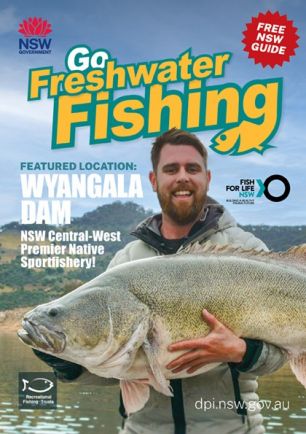
Go Fishing - Wyangala Dam
 Situated about 30km from Cowra in Central West NSW, Wyangala Dam captures the waters of the Abercrombie and Lachlan rivers for town water and Irrigation supply. Wyangala is part of the Murray-Darling Basin and its flows enter the Lachlan River which eventually joins the Murrumbidgee River and then onto the mighty Murray River further downstream.
Situated about 30km from Cowra in Central West NSW, Wyangala Dam captures the waters of the Abercrombie and Lachlan rivers for town water and Irrigation supply. Wyangala is part of the Murray-Darling Basin and its flows enter the Lachlan River which eventually joins the Murrumbidgee River and then onto the mighty Murray River further downstream.
At 100% capacity the dam holds 1,220,000 ML of water at 379m elevation having a depth of 79m at its deepest point. The surface area of Wyangala Dam is 5,390 ha (13,300 acres) and the catchment area is 8,300 km2.
Construction on Wyangala started in 1928, making it the second oldest dam built for irrigation in NSW. Due to its age, Wyangala is known as one of Central NSW’s most productive and popular recreational fishing impoundments.
The rugged mountains surrounding this dam are forested with stands of cypress pine and eucalyptus, making for excellent camping at select locations along the foreshores.
Natural campsites which can be accessed by vehicles including the popular Markhams, Oaky Creek, Quart Pot and Gerties.
There are two main tourist parks situated on Wyangla’s foreshores. Wyangala State Recreational Area is located at the main wall with accommodation options ranging from campsites, cabins, onsite vans and house boats; the other park is the Grabine State Recreational Area, which is situated on what was the old junction of the Lachlan and Abercrombie rivers.
Grabine is about 20kms from the small township of Bigga and has all the facilities required for an enjoyable family stay.
Bush camping is also allowed on the dam’s foreshores and many people take advantage of this by loading up their boats with their camping gear and travelling to remote campsites for peace and quiet.
History is rich in the Wyangala Dam area with the “Wild Abercrombies” a favoured haunt of bushrangers such as Frank Gardiner, John Vane and others like John Piesely, who has the dubious honour of being the first Australian-born bushranger to die on the gallows at nearby Bathurst.
Mining also played a huge part in the development of this area. The hills and gullies in and around Wyangala were once rich with gold, copper, and other minerals; evidence of these past workings can be seen along the banks in some parts of the dam.
The natural structure around the dam is visually impressive with giant granite tors towering above drowned boulders and rock piles which are favoured haunt of big Murray cod.
Drowned forests in various bays and in the arms of the dam attract schools of golden perch which congregate around the sunken trees.
The flats created by sloping banks can fish well early in the spring for species like silver perch and eel tailed catfish. These species are protected in streams and rivers but are available to be caught and kept for a tasty feed in Wyangala Dam.
As the waters warm during spring and summer, invasive European carp will mooch along the shallow edges, offering anglers excellent sight fishing by casting flies, lures, and baits to cruising fish.
Another introduced pest species, the redfin or English perch, has been unfortunately discovered in Wyangala Dam but is yet to be found in large numbers. It is hoped Murray cod and golden perch are predating on the redfin and keeping their numbers in check.
Protected species such as Macquarie perch and trout cod can be found in waters from the dam up in the feeder streams above. Murray crays and the small freshwater blackfish (known locally as “slipperies”) can also be found in the rivers and creeks above the dam. Both are protected from fishing and should be released if caught.
The excellent fishing and camping opportunities offered by Wyangala are the prime reasons why this waterway is rated by many as the No.1 fishing dam in Central Western NSW.
Plan a trip to see for yourself!

